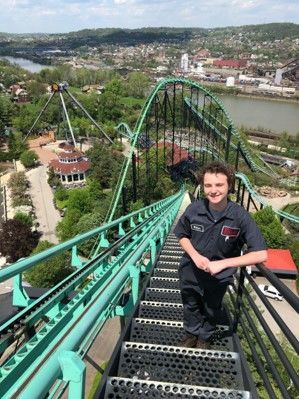William Friedlander, a senior Mechanical Engineering major, can pinpoint the exact moment he knew what he wanted to be when he grew up. It was 2006, he was in the second grade, and his big brother was seated next to him on the Phantom’s Revenge, a steel coaster at Kennywood Park near his hometown of Pittsburgh.
“My brother was sort of terrorizing me and telling me how scared I was going to be as we climbed the first hill,” Friedlander said. “But the second we crested and started to fall, I was hooked. It was exhilarating.”
By fourth grade, he had talked his parents into taking him to Cedar Point, the “roller coaster capital of the world,” in Sandusky, Ohio. He was too short to ride the biggest coasters, but cut his teeth on the Maverick, his first propulsion launch coaster. Then, with wobbling knees, he boarded the Top Thrill Dragster, which takes riders from zero to 122 miles per hour in 3.8 seconds for an adrenaline-packed 17-second ride.
“When I got off the Dragster, I had the same feeling that I did the first time I rode Phantom’s Revenge,” he said. “It just fed my obsession.”
As did K’NEX, the building toy. When he was in fifth and sixth grade, he commandeered an entire room in his home to build an elaborate amusement park, using more than 20,000 pieces of K’NEX.
“My parents were very understanding,” he said. “I just let my imagination run wild.”
But Friedlander didn’t just dream, he prepared. When he was in middle school, he e-mailed roller coaster design companies to ask for advice on being a coaster engineer. They suggested he get a mechanical engineering degree and any experience he could working with roller coasters.
As a teen, he got a job as a ride operator on Phantom’s Revenge, the coaster that had ignited his passion. The next year, he worked on the ride’s maintenance and operations team, where he got an up-close look at the mechanics and safety features.
Friedlander chose Behrend for several reasons: “It offered M.E., had a reputation as one of the top undergraduate engineering schools, and offered the smaller class sizes I wanted,” he said.
In the fall semester of his junior year, he did his first internship/co-op at Premier Rides, a roller coaster design company in Baltimore, Maryland.
“I learned they had internships available and I called them weekly for three months. Kathy inHuman Resources and I became pretty good friends,” he said with
a laugh.
He did an internship in Premier’s parts and service department. The position involved monitoring coaster parts inventory and assisting clients, but he also had the opportunity to analyze the braking system for one of the company’s rides.
“I had no background in pneumatic systems at all, so it was a great educational experience,” he said.
This past summer, Friedlander returned to Premier, where he worked as a project engineering intern. “I was involved in redesigning, prototyping, and testing a lap bar for a restraint system and evaluating rider containment with another intern who had started the project before I got there,” he said.
Friedlander wants you to know that roller coasters are safer than your average automobile.
“You’d be surprised to see all the safety standards and the daily inspection that occur,” he said. “Every single restraint is tested every day. And there are several fail-safes, which are backups for any safety feature. So even if one thing did fail, there would be two or three other means of preventing disaster.”
Another popular misconception about roller coasters? “They never leave the track. Ever,” he said. “It may feel that way because your body experiences zero gravity or negative gravity, in which you lift up off the seat, but the car is actually secured to the track by wheels on both the top and bottom.”
Premier was so impressed with Friedlander and his work that it sponsored a senior capstone project. Friedlander and three other Mechanical Engineering majors—Hailee Crimbchin, Dakota Hetrick, and Kaitlin Peterman—are designing a measurement system to analyze forces and stresses on coaster components and come up with a set of standards.
“There are lots of industry standards for how ride dynamics are measured,” he said. “But not many standards for measuring components of the
coaster,” he said. “That’s what we are developing. I want to be clear, though, that there are already many calculations and simulations to ensure components are safe, but a means to measure after-the-fact is another way of verifying the calculations.”
Friedlander’s myriad experiences in all facets of coaster culture from operation to design to maintenance has helped him nail down exactly what he hopes to do after his graduation in May.
“I’d like to be a field engineer for a roller coaster design company,” he said. “This is the onsite engineer who builds the coaster and solves any onsite issues. People are so stressed out today. I want to build rides that give them some joy and let them escape their worries, even if only for a minute or two.”
